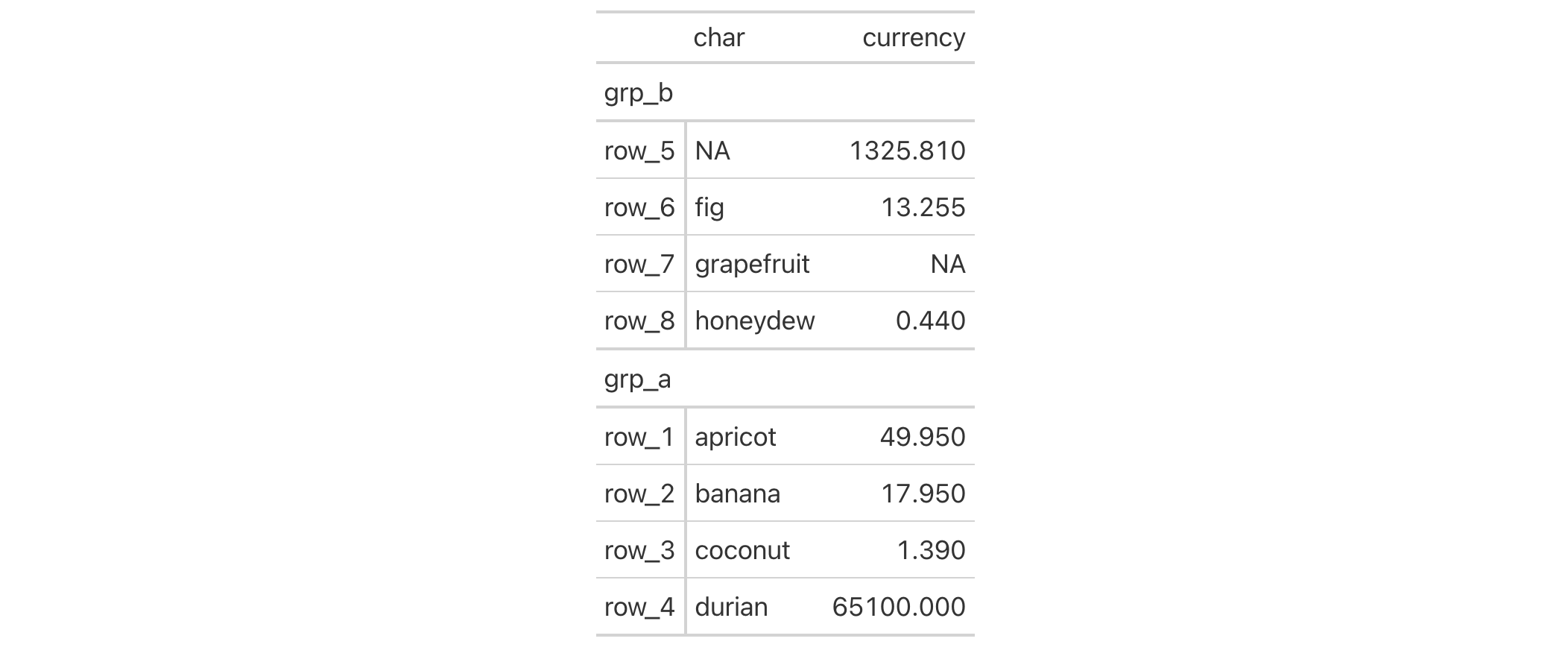row_group_order: Modify the ordering of any row groups
In rstudio/gt: Easily Create Presentation-Ready Display Tables
row_group_order R Documentation
Modify the ordering of any row groups
Description
We can modify the display order of any row groups in a gt object with
row_group_order(). The groups argument takes a vector of row group ID
values. After this function is invoked, the row groups will adhere to this
revised ordering. It isn't necessary to provide all row ID values in
groups, rather, what is provided will assume the specified ordering at the
top of the table and the remaining row groups will follow in their original
ordering.
Usage
row_group_order(data, groups)
Arguments
data
The gt table data object
obj:<gt_tbl> // required
This is the gt table object that is commonly created through use of the
gt() function.
groups
Specification of row group IDs
vector<character> // required
A character vector of row group ID values corresponding to the revised
ordering. While this vector must contain valid group ID values, it is not
required to have all of the row group IDs within it; any omitted values
will be added to the end while preserving the original ordering.
Value
An object of class gt_tbl.
Examples
Let's use exibble to create a gt table with a stub and with row
groups. We can modify the order of the row groups with row_group_order(),
specifying the new ordering in groups.
exibble |>
dplyr::select(char, currency, row, group) |>
gt(
rowname_col = "row",
groupname_col = "group"
) |>
row_group_order(groups = c("grp_b", "grp_a"))

Function ID
6-3
Function Introduced
v0.2.0.5 (March 31, 2020)
See Also
Other row addition/modification functions:
grand_summary_rows(),
rows_add(),
summary_rows()
rstudio/gt documentation built on March 29, 2025, 4:02 a.m.
| row_group_order | R Documentation |
Modify the ordering of any row groups
Description
We can modify the display order of any row groups in a gt object with
row_group_order(). The groups argument takes a vector of row group ID
values. After this function is invoked, the row groups will adhere to this
revised ordering. It isn't necessary to provide all row ID values in
groups, rather, what is provided will assume the specified ordering at the
top of the table and the remaining row groups will follow in their original
ordering.
Usage
row_group_order(data, groups)
Arguments
data |
The gt table data object
This is the gt table object that is commonly created through use of the
|
groups |
Specification of row group IDs
A character vector of row group ID values corresponding to the revised ordering. While this vector must contain valid group ID values, it is not required to have all of the row group IDs within it; any omitted values will be added to the end while preserving the original ordering. |
Value
An object of class gt_tbl.
Examples
Let's use exibble to create a gt table with a stub and with row
groups. We can modify the order of the row groups with row_group_order(),
specifying the new ordering in groups.
exibble |>
dplyr::select(char, currency, row, group) |>
gt(
rowname_col = "row",
groupname_col = "group"
) |>
row_group_order(groups = c("grp_b", "grp_a"))

Function ID
6-3
Function Introduced
v0.2.0.5 (March 31, 2020)
See Also
Other row addition/modification functions:
grand_summary_rows(),
rows_add(),
summary_rows()
Add the following code to your website.
For more information on customizing the embed code, read Embedding Snippets.
